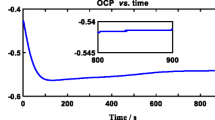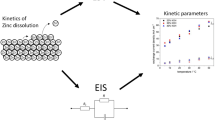Abstract
Anodic nickel dissolution in acid media has been analyzed by means of electrochemical quartz crystal microbalance and electrochemical impedance spectroscopy techniques. The experimental impedance spectra have been fitted to an equivalent circuit which is related to a mechanism of two consecutive electron transfers followed by a Ni2+ mass transfer step. That way, an estimation for values of rate constants and surface concentrations of the Ni(0), Ni(I) and Ni(II) species has been obtained.




Similar content being viewed by others
References
Arvía AJ, Posadas D (1975) In: Bard AJ (ed) Encyclopedia of electrochemistry of the elements, vol 3. Marcel Dekker, New York, p 211
Sato N, Okamoto G (1981) In: Bockris JO, Conway BE, Yeager E, White RE (eds), Electrochemical materials science, vol. 4. Plenum, New York, p 193
Real SG, Vilche JR, Arvía AJ (1980) Corros Sci 20:563
Barbosa MR, Real SG, Vilche JR, Arvía AJ (1988) J Electrochem Soc 135:1077
MacDougall B (1979) J Electrochem Soc 126:919
Abd El Rehim SS, Abd El Wahaab SM, Abd El Meguid EA (1986) Surf Coat Technol 29:325
Jouanneau A, Keddam M, Petit MC (1976) Electrochim Acta 21:287
Barbosa MR, Bastos JA, Gacía-Jareño JJ, Vicente F (1998) Electrochim Acta 44:957
Keddam M, Takenouti H, Yu N (1985) J Electrochem Soc 132:2561
Keddam M (1995) In: Marcus P, Oudar J (eds), Corrosion mechanism in theory and practice. Marcel Dekker, New York, pp 55–122
Itagaki M, Nakazawa H, Watanabe K, Noda K (1997) Corros Sci 39:901
Giménez-Romero D, García-Jareño JJ, Vicente F (2003) J Electroanal Chem 558:25
Giménez-Romero D, García-Jareño JJ, Vicente F (2002) Electrochem Commun 4:613
Shao HB, Wang JM, Zhang Z, Zhang JQ, Cao CN (2003) J Electroanal Chem 549:145
Bard AJ, Faulkner LR (2001) Electrochemical methods. fundamentals and applications, 2nd edn. Wiley, New York, pp 316–370
Macdonald DD (1990) Electrochim Acta 35:1509
Macdonald DD (1977) Transient techniques in electrochemistry. Plenum, New York, pp 229–311
Epelboin I, Gabrielli C, Keddam M (1975) Corros Sci 15:155
Vanmaekelbergh D, Erné BH (1999) J Electrochem Soc 146:2488
Berthier F, Diard JP, Michel R (2001) J Electroanal Chem 510:1
Gabrielli C (1983) Identification of electrochemical processes by frequency response analysis. Solartron Instrumentation Group, Farnborough
Keddam M, Mattos OR, Takenouti H (1981) J Electrochem Soc 128:257
Keddam M, Mattos OR, Takenouti H (1981) J Electrochem Soc 128:266
Sanchez S, Picard GS (1996) Electrochim Acta 41:2035
Péter L, Arai J, Akahoshi H (2000) J Electroanal Chem 582:125
Armstrong RD, Firman RE, Thirsk HR (1973) Faraday Discuss 56:44
Macdonald JR (1992) Solid State Ionics 58:97
Vicente F, García-Jareño JJ, Sanmatías A (2000) Procesos Electródicos del NAFIÓN y del Azul de Prusia sobre electrodo transparente de óxido de indio-estaño: un modelo de electrodo multicapa. Moliner-40, Burjassot
Lachenwitzer A, Magnussen OM (2000) J Phys Chem B 104:7424
Giménez D, García-Jareño JJ, Vicente F Materiales y Procesos Electródicos I (2002). INSDE, València, pp 65–84
Sauerbrey G (1959) Z. Physik 155:206
Song KD, Kim KB, Han SH, Lee HK (2003) Electrochem Commun 5:460
Lachenwitzer A, Morin S, Magnussen OM, Behm RJ (2001) Phys Chem Chem Phys 3:3351
Wiart R (1990) Electrochim Acta 35:1587
Gabrielli C, Keddam M (1996) Electrochim Acta 41:957
Jouanneau A, Petit MC (1976) J Chim Phys 73:82
Giménez-Romero D, García-Jareño JJ, Vicente F (2003) J Electroanal Chem (in press)
Real SG, Barbosa MR, Vilche JR, Arvía AJ (1990) J Electrochem Soc 137:1696
Gregori J, Agrisuelas J, Gimenez D, Peña MP, Garcia-Jareno JJ, Vicente F (2003) Rev Metal 39:346
Diard J-P, Le Gorrec B, Montella C (1996) Cinétique Électrochimique. Collection Méthodes, Hermann, Paris
Diard J-P, Le Gorrec B, Montella C, Montero-Ocampo C (1993) J Electroanal Chem 352:1
Acknowledgements
This work has been supported by CICyT-Mat/2000-0-P4. D. Giménez-Romero acknowledges a Fellowship from the Generalitat Valenciana (FPI program). J. Gregori acknowledges a Fellowship from the Spanish Education Ministery (FPU program). J.J. García-Jareño acknowledges the financial support of the program “Ramón y Cajal” from the Spanish Science and Technology Ministry.
Author information
Authors and Affiliations
Corresponding author
Appendices
Appendix 1
A mathematical method, similar to that used by Diard et al. [40, 41] for the Volmer–Heyrovsky reduction mechanism, was used for obtaining the theoretical impedance function of the anodic dissolution of the metal. It can be considered that a metal dissolves by means of two consecutive electron transfers followed by a transport step, according to the reaction scheme:
where r1, r2 and r3 are the reaction rates for each elementary step. Me(I) and Me(II) are the reaction intermediates.
The charge balance at the electrode surface defines the faradaic current:
where A and F are the electrode surface and the Faraday constant, respectively. The mass balance at the electrode surface, for each reaction intermediate, is described by the equations:
where θ0, θ1 and θ2 are the surface concentrations of Me(0), Me(I) and Me(II) species at the electrode surface and θ0 is the initial concentration of free sites at the electrode surface. r1, r2, r3, θ0, θ1 and θ2 will be a function of potential E and θ i . If each elementary step obeys kinetics of first order, it can be expressed as:
If a small sinusoidal perturbation of potential is applied around a defined steady state at a potential E0, we can write the Taylor expansion for Eqs. (A4), (A5), (A6) and (A7) around this steady state in the Laplace plane. If the amplitude of the potential perturbation is small, only the terms of first order need be considered:
where p=jω is the Laplace variable. Dividing each term of Eqs. (A11), (A12) and (A13) by Δi F an equation system for \( Z_{F} = \Delta E/\Delta i_{F} \), \( \Delta \theta _{1} /\Delta i_{F} \) and \( \Delta \theta _{2} /\Delta i_{F} \) is defined, where Z F is the faradaic impedance which can be determined by means of the Kramer’s rule:
Appendix 2
When chloride ion is present in the acid medium the experimental impedance spectra are fitted to the equivalent circuit of Fig. 4. The faradaic impedance function for this equivalent circuit is:
If Eq. (A15) is compared with Eq. (11), the following equation system can be written:
which can be simplified as in the previous case (two capacitive loops). If R and C1 are very low and if it is considered that k1≫k2,k3, the following equation system is obtained:
Rights and permissions
About this article
Cite this article
Gregori, J., García-Jareño, J.J., Giménez-Romero, D. et al. Kinetic calculations of the Ni anodic dissolution from EIS. J Solid State Electrochem 9, 83–90 (2005). https://doi.org/10.1007/s10008-004-0557-2
Received:
Accepted:
Published:
Issue Date:
DOI: https://doi.org/10.1007/s10008-004-0557-2




